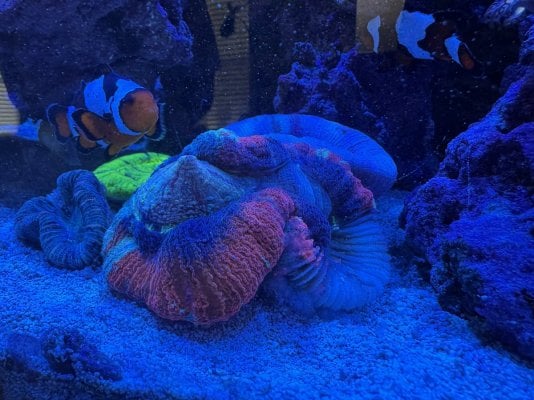Navigation
Install the app
How to install the app on iOS
Follow along with the video below to see how to install our site as a web app on your home screen.
Note: This feature may not be available in some browsers.
More options
You are using an out of date browser. It may not display this or other websites correctly.
You should upgrade or use an alternative browser.
You should upgrade or use an alternative browser.
Can I help my Trachy?
- Thread starter MR2MAS
- Start date
- Tagged users None
I haven’t tested calcium. It’s been going for a couple of weeks now. It’s slowly getting worse.What is your calcium reading?
How quickly did this happen?
Mine started receding very slowly than algae grew on the skeleton and that seemed to speed up the wasting.
I did a hydrogen peroxide dip and put coral glue on the open skeleton, that seemed to stop the spread.
Seal up all open wounds.
I did a hydrogen peroxide dip and put coral glue on the open skeleton, that seemed to stop the spread.
Seal up all open wounds.
They can recover, the biggest concern is keeping a bacterial infection away.
Did you find out what caused the initial receeding? Did you have a dip or spike in Alk or nutrients? If the issue was corrected and you can keep bacteria from attacking it you can have a chance of getting it to recover.
Frequent spot feeding is going to be essential to recovery.
Did you find out what caused the initial receeding? Did you have a dip or spike in Alk or nutrients? If the issue was corrected and you can keep bacteria from attacking it you can have a chance of getting it to recover.
Frequent spot feeding is going to be essential to recovery.
So I just tried measuring calcium and I think I might be on the high side.
I’m using the Red Sea kit and the color didn’t change after using up the 1ml of titrant.
I’m going to do a 20% water change to see if it helps.
Before I did a hydrogen peroxide dip before and after the KFC dip.
I’m using the Red Sea kit and the color didn’t change after using up the 1ml of titrant.
I’m going to do a 20% water change to see if it helps.
Before I did a hydrogen peroxide dip before and after the KFC dip.
Anything near the coral that would potentially be attacking it after the lights are out?
As @Frags 2 Fishes said, I find feeding meaty corals daily when they are bad like this helps a lot. Keep algae off the skeleton. Check for baby bristleworms taking residence inside the skeleton (think the dip probably took care of that). Check that it isn't receiving full force flow right there on the skeleton. And keep feeding it. I gove mine medium sized TDO pellets in each mouth.
I thought about that and that's why I decided to put it in a cage for protection. I only took the cage off to check and take a picture. The cage is back on now.Anything near the coral that would potentially be attacking it after the lights are out?
I'll give this a go after my water change. I actually laid off the manual feeding after I dipped it thinking I might be overfeeding it. But I can easily go back to daily feeds.As @Frags 2 Fishes said, I find feeding meaty corals daily when they are bad like this helps a lot. Keep algae off the skeleton. Check for baby bristleworms taking residence inside the skeleton (think the dip probably took care of that). Check that it isn't receiving full force flow right there on the skeleton. And keep feeding it. I gove mine medium sized TDO pellets in each mouth.
I'm hoping it's recover. It's one of my favorite pieces.They can recover, the biggest concern is keeping a bacterial infection away.
Did you find out what caused the initial receeding? Did you have a dip or spike in Alk or nutrients? If the issue was corrected and you can keep bacteria from attacking it you can have a chance of getting it to recover.
Frequent spot feeding is going to be essential to recovery.
I haven't truly found out what may be causing this. My tests been pretty steady, with the exeption of calcium which honestly I don't ready test. I've been monitoring alk, pH, salinity, nitrates, and phosphates.
Maybe it's a signal to get the Maven? lol
But I will start spot feeding immediately.
S
Good Idea. With how puffed out it is everywhere else on the coral, I tend to think it’s unique to that spot (high flow, being attacked) versus water quality.I thought about that and that's why I decided to put it in a cage for protection. I only took the cage off to check and take a picture. The cage is back on now.
Last edited:
I haven’t tested calcium. It’s been going for a couple of weeks now. It’s slowly getting worse.
I've had this happen. My calcium was only 320 when it happened.
If you have corals, calcium is an important parameter. Buy a calcium test kit and test. Report back with the number.
Maybe you can ask your local fish store to test your calcium?
Similar threads
- Replies
- 18
- Views
- 405
- Replies
- 6
- Views
- 111




















